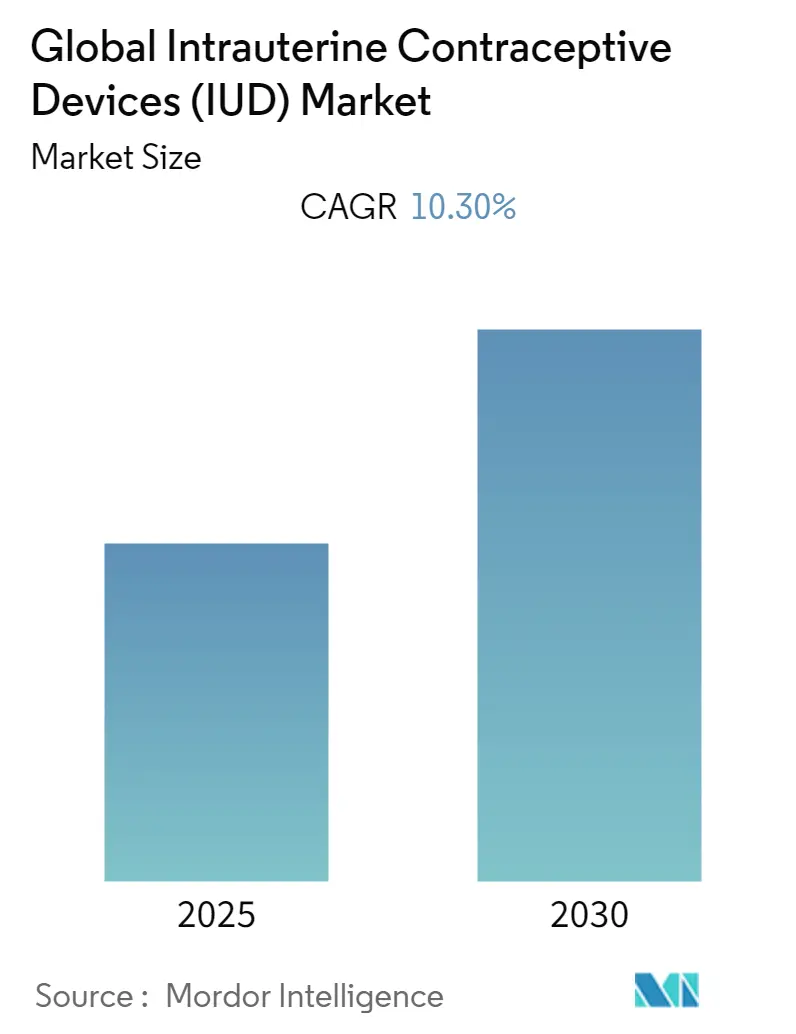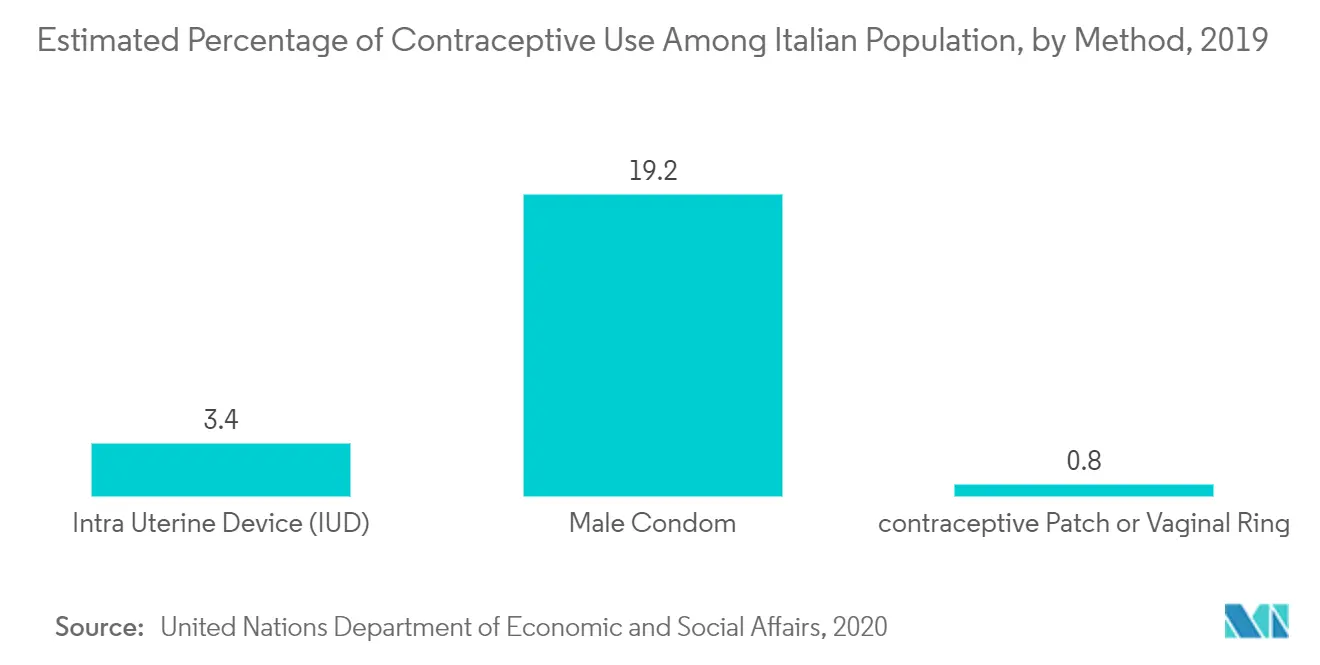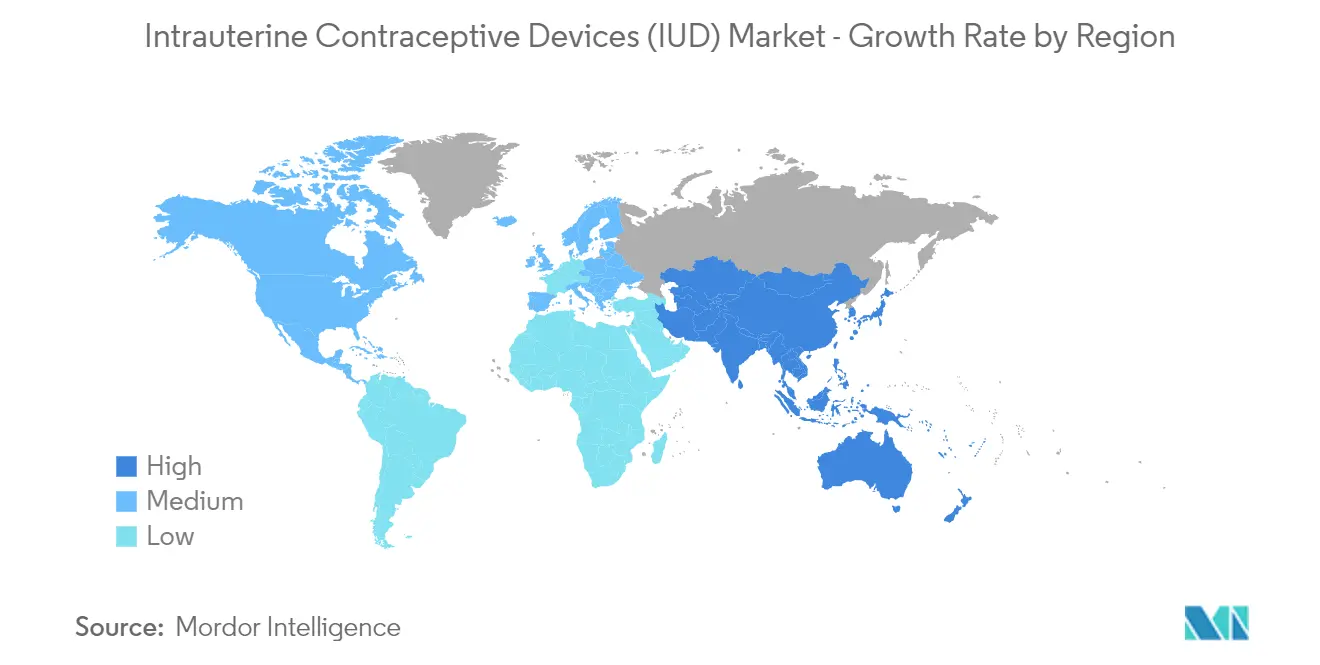
Intrauterine Contraceptive Devices Market Analysis
The Global Intrauterine Contraceptive Devices Market is expected to register a CAGR of 10.3% during the forecast period.
During the COVID-19 pandemic 2020 and increasing cases of COVID-19 worldwide, the health care emphasis has shifted to focus on the apportionment of resources, prevention of viral spread, emergent medical care, and the development of novel treatments and vaccines. Moreover, the unfortunate byproduct of this shift is the de-prioritization of other essential health care services such as access to contraception.
According to a resarch study by Anita Makins et al., published in Gynecology & Obstetrics Journal May 2020, during the COVID-19 pandemic 2020, there was an impending stock-outs of contraceptive methods which are about to ensue. Moreover, United Nations Population Fund (UNFPA) estimates that during the next six months from May 2020, 46 countries that usually receive supplies from them will experience stock-outs of one or more modern methods, including copper intrauterine devices, implants, depot medroxyprogesterone acetate (DMPA) intramuscular (IM) and subcutaneous (SC), oral contraceptive pills (combined and progestin only) and condoms.
In addition, according to the research study by Aisha Dasgupta et al., published in Gates Open Research November 2020, globally, it had been estimated that 77% of women of reproductive age (15-49 years) would have their need for family planning satisfied with modern contraceptive methods in the year 2020. However, taking into account the potential impact of COVID-19 on method-specific use, this could fall to 71%, resulting in around 60 million fewer users of modern contraception worldwide in 2020.
The major factors for the growth of the intrauterine contraceptive devices (IUD) market include the technological innovations leading to effective contraception and fewer side effects, increasing rate of unintended pregnancies, and supportive government initiatives and private firms for the prevention of unwanted abortions and pregnancies.
Unintended pregnancy is an undesired conception. Not using contraception or incorrect use of contraceptive methods can result in unintended pregnancy. The percentage of unintended pregnancies is highest in teens younger than 18 years, followed by women in the age group of 20 to 24 years. These unintentional pregnancies are directly contributing to the raised demand for contraceptive devices.
Moreover, the number of unwanted pregnancies are increasing, and this has become one of serious concerns, globally. For instance, according to World Health Organization (WHO), unintended pregnancies have been an important public health issue. Globally, about 22 million unsafe abortions were estimated to take place each year, which result in the death of an estimated 47,000 women, as per the International Federation of Medical Students' Associations 2018 report.
However, over the past few years, the awareness of contraception has contributed to both the decline in unplanned pregnancies and the growth of the contraception market. Family planning efforts, which include increasing access to intrauterine contraceptive devices, can help reduce unintended pregnancies. The use of IUDs decreased the proportion of births that were unplanned. The usage of IUD is increasing year on year as women find IUD the most convenient, safe, and effective form of contraception.
For instance, according to a research study by Ghzl Ghazi Alenezi et al., published in Middle East Fertility Society Journal April 2021, the study results found that most women in urban Hail community, northern Saudi Arabia, were aware about and have a positive attitude towards family planning. About two-thirds of population were currently using any contraceptive method/s, which is higher than the national estimate for Saudi Arabia. Therefore, the market studied is expected to be driven by the increasing unintended pregnancies, worldwide. However, factor such as risk of causing pelvic inflammatory infection (PID) is likley to impede the market growth in near future.
Intrauterine Contraceptive Devices Market Trends
The Copper Intrauterine Device Segment is Expected to Hold Significant Market Share During the Forecast Period
Copper IUDs have been in the market for a long time, since about 1988, earlier than the hormonal IUDs. One of the advantages of using copper IUDs is that they can be used as emergency contraceptives. They can be used within five days of unprotected intercourse to prevent pregnancy. Unlike the hormonal IUD, where the user has to wait for two days for the IUD to take effect, copper IUDs are functional immediately after insertion. They are also less expensive in comparison to hormonal IUDs.
According to the research study conducted by the United Nations sexual and reproductive health agency (UNFPA) in 2020, projects that more than 47 million women could lose access to contraception leading to 7 million unintended pregnancies as a result of the COVID-19 crisis. The devastating result of unintended pregnancy is an increase in maternal and neonatal morbidity and mortality.
According to the research study by Jasmine Aly et al., published in Contraception and Reproductive Medicine October 2020, emphasizes the disproportionate rate of unintended pregnancy in developing countries, which preceded COVID-19. In addition, the study data suggest that, even prior to the COVID-19 crisis 2020, a high rate of women with unmet need for contraception was observed. With the additional strain imposed by COVID-19, populations within an already burdened healthcare system will be most vulnerable.
Increasing research and development activities in the development of novel devices is also boosting the market growth. For instance, Cairo University is conducting a clinical trial to assess the safety and efficacy of intrauterine copper device in patients undergoing cesarean delivery. The trial started in December 2020 and expected to complete in April 2022.
Moreover, cheaper price of these devices has made IUD the one of the most used contraceptive devices in the United States. According to the 2018 report by the Center for Diseases Control and Prevention, 10.3% of women aged 15-49 currently use long-acting reversible contraception (Intrauterine device or contraceptive implant). This number has increased steadily over the years and expected to increase in future as well with more awareness about the advantages of the devices which is expected to help the segment growth over the forecast period.

North America Dominates the Market and Expected to do Same in the Forecast Period
IUDs are one of the most effective forms of reversible contraception, and the interest in this method is growing among women and healthcare providers. The United States market has shown the greatest demand in the use of both hormone-free copper, as well as hormone-based IUDs. For instance, according to the research article published in 2018, 'Contraceptive Use in the United States', it was estimated that about 62 million American women used contraceptives in their childbearing years (15-44). It was observed that approximately 43 million of them (70%) are at risk of unintended pregnancy, i.e., they are sexually active and do not want to become pregnant. However, the article indicates that they may become pregnant, if they and their partners fail to use a contraceptive method correctly and consistently.
The COVID-19 pandemic 2020 is a public health crisis with wide reaching health care implications due to illnesses from the disease itself, social and physical distancing restrictions, and the deferral or indefinite postponement of non-urgent clinical care and procedures. As physical and social distancing measures have been implemented to curb the spread of COVID-19 in North America region, healthcare has been upended with the deferral or cancellation of in-person visits and health care providers have had to rapidly adapt their clinical practice.
For instance, according to a research study by Amanda Black et al., published in Society of Obstetricians and Gynaecologists of Canada (SOGC) 2020, stated that Canadian people and couples who want to avoid a pregancy during the COVID-19 pandemic 2020 are at increased risk of developing an unmet need for family planning due to lack of access to contraceptive care or methods. Adding to this, social isolation may increase unintended pregnancy through exposure to unprotected intercourse, reproductive coercion, and intimate personal violence.
The three most common types of hormonal IUDs available and trending in the United States market are Mirena, Skyla, and Liletta. The American College of Obstetricians and Gynecologists has now developed new guidelines to make IUDs popular among patients. It has been endorsed by the American Academic of Pediatrics as the first line of contraceptive option for teenage girls. Thus, owing to the presence of better healthcare infrastructure and awareness among the population, the North American intrauterine contraceptive devices (IUD) market is expected to grow during the forecast period.

Intrauterine Contraceptive Devices Industry Overview
The Intrauterine Contraceptive Devices (IUD) Market studied is consolidated, owing to the presence of a few major market players. The market players in the intrauterine contraceptive devices (IUD) market are adopting strategies, such as mergers and acquisitions, technological developments, and geographical expansions, in order to capture a significant position. Some of the market players are Abbvie Inc (Allergan Plc), Bayer AG, CooperSurgical Inc., DKT International, EUROGINE, S.L, among others.
Intrauterine Contraceptive Devices Market Leaders
-
Abbvie Inc (Allergan Plc)
-
Bayer AG
-
CooperSurgical Inc.
-
DKT International
-
EUROGINE, S.L
- *Disclaimer: Major Players sorted in no particular order
Intrauterine Contraceptive Devices Market News
In June 2021, Sebela Pharmaceuticals Inc., in collaboration with PRA Health Sciences is conducting a phase III clinical trial to assess LevoCept, a long-acting reversible intrauterine system for contraceptive efficacy, safety and tolerability. The trial expected to complete in June 2027.
In February 2020, Agile Therapeutics, Inc., received approval from U.S. Food and Drug Administration (FDA) for Twirla (levonorgestrel and ethinyl estradiol) transdermal system which is indicated as a method of contraception for use in women of reproductive potential with a BMI of 30 kg/m2 for whom a combined hormonal contraceptive is appropriate.
Intrauterine Contraceptive Devices Industry Segmentation
As per the scope of this report, an intrauterine device (IUD or coil) is a small contraceptive device, often 'T'-shaped, containing either copper or levonorgestrel, which is inserted into the uterus. It is one form of long-acting reversible contraception, which is the most effective type of reversible birth control. The Intrauterine Contraceptive Devices (IUD) Market is segmented by Type (Hormonal Intrauterine Device, Copper Intrauterine Device), End User (Hospitals, Gynecology Clinics and Community Health Care Centers) and Geography (North America, Europe, Asia-Pacific, Middle East and Africa, and South America). The report offers the value (in USD million) for the above segments. The market report also covers the estimated market sizes and trends for 17 different countries across major regions globally.
| By Type | Hormonal Intrauterine Device | ||
| Copper Intrauterine Device | |||
| By End User | Hospitals | ||
| Gynecology Clinics | |||
| Community Health Care Centers | |||
| Geography | North America | United States | |
| Canada | |||
| Mexico | |||
| Europe | Germany | ||
| United Kingdom | |||
| France | |||
| Italy | |||
| Spain | |||
| Rest of Europe | |||
| Asia-Pacific | China | ||
| Japan | |||
| India | |||
| Australia | |||
| South Korea | |||
| Rest of Asia-Pacific | |||
| Middle East and Africa | GCC | ||
| South Africa | |||
| Rest of Middle East and Africa | |||
| South America | Brazil | ||
| Argentina | |||
| Rest of South America | |||
Intrauterine Contraceptive Devices Market Research FAQs
What is the current Global Intrauterine Contraceptive Devices (IUD) Market size?
The Global Intrauterine Contraceptive Devices (IUD) Market is projected to register a CAGR of 10.3% during the forecast period (2025-2030)
Who are the key players in Global Intrauterine Contraceptive Devices (IUD) Market?
Abbvie Inc (Allergan Plc), Bayer AG, CooperSurgical Inc., DKT International and EUROGINE, S.L are the major companies operating in the Global Intrauterine Contraceptive Devices (IUD) Market.
Which is the fastest growing region in Global Intrauterine Contraceptive Devices (IUD) Market?
Asia Pacific is estimated to grow at the highest CAGR over the forecast period (2025-2030).
Which region has the biggest share in Global Intrauterine Contraceptive Devices (IUD) Market?
In 2025, the North America accounts for the largest market share in Global Intrauterine Contraceptive Devices (IUD) Market.
What years does this Global Intrauterine Contraceptive Devices (IUD) Market cover?
The report covers the Global Intrauterine Contraceptive Devices (IUD) Market historical market size for years: 2019, 2020, 2021, 2022, 2023 and 2024. The report also forecasts the Global Intrauterine Contraceptive Devices (IUD) Market size for years: 2025, 2026, 2027, 2028, 2029 and 2030.
Our Best Selling Reports
Intrauterine Contraceptive Devices Industry Report
Statistics for the 2025 Global Intrauterine Contraceptive Devices (IUD) market share, size and revenue growth rate, created by Mordor Intelligence™ Industry Reports. Global Intrauterine Contraceptive Devices (IUD) analysis includes a market forecast outlook for 2025 to 2030 and historical overview. Get a sample of this industry analysis as a free report PDF download.




